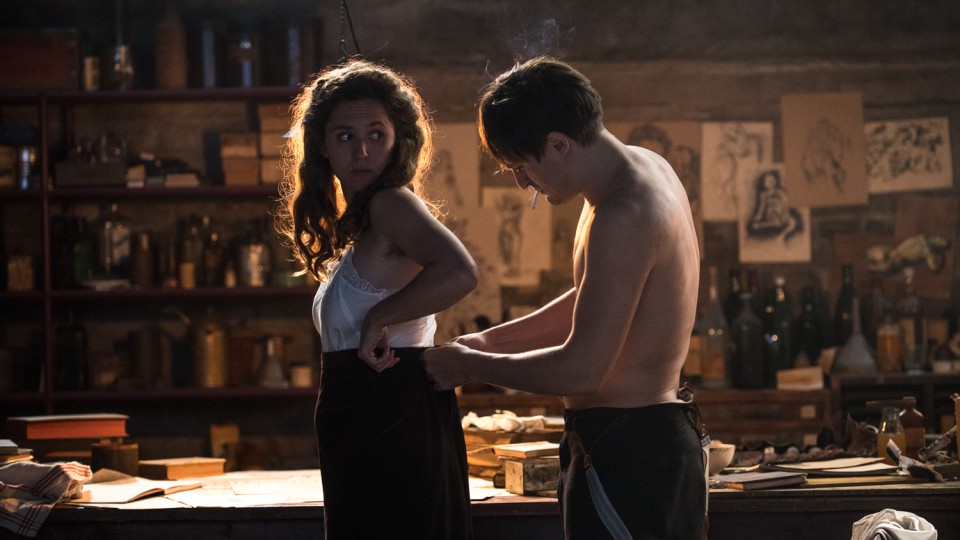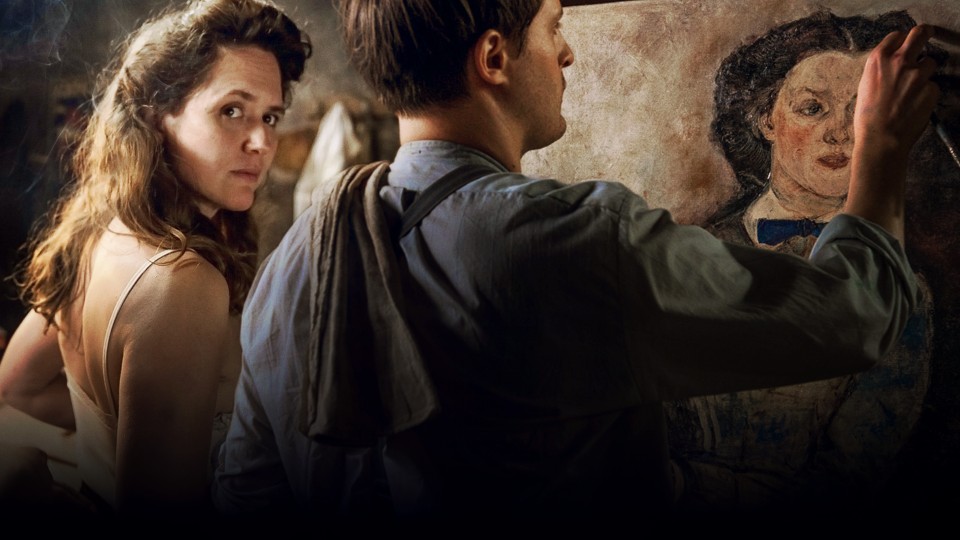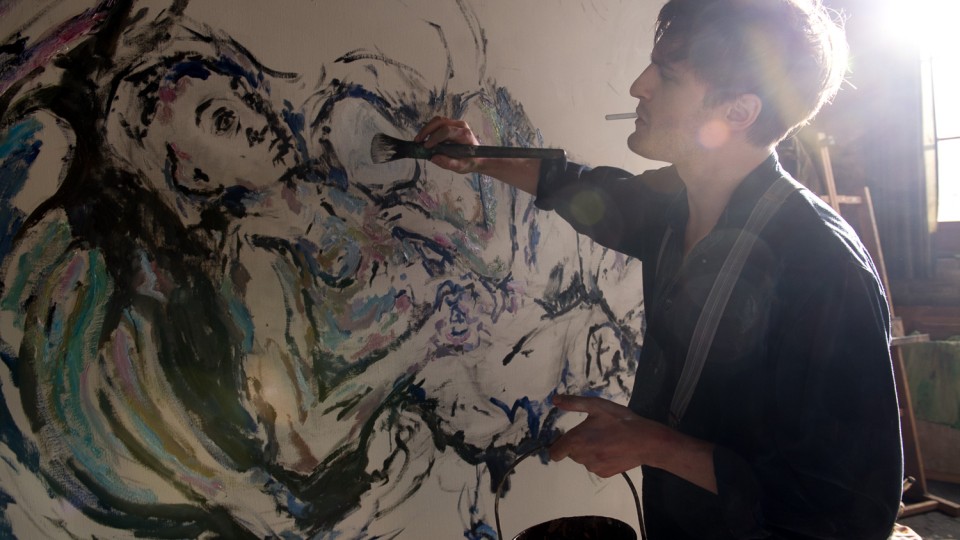Alma Mahler is often reduced to being labelled "the wife of...". At some point, when Gustav Mahler was no longer alive and
his widow was in the process of forging plans for the future with the architect Walter Gropius, Oskar Kokoschka appeared on
the scene. He would have been only too happy to be united with her in matrimony. That never happened. But what did take place
was an explosive affair. Dieter Berner and screenwriter Hilde Berger, in their depiction of ALMA & OSKAR, present the battle between the sexes as it begins to erupt at the turn of the century
along with a musician whose talent
has received little attention.
Hilde Berger, you are not only a screenwriter but also a novelist; your first novel focused on the love affair between Alma
Mahler and Oskar Kokoschka. Do you remember what interested you at that time about this gripping love story? Did you approach
this relationship from the perspective of Alma or Oskar?
HILDE BERGER: I was interested in the combative relationship between them and the way the man creates an image of the woman – particularly
since he is a painter – which doesn’t correspond to reality. They are both such interesting personalities, it was hard to
choose one main perspective. In the script we tried to do justice to both points of view, whereby Oskar Kokoschka adopts more
of an imaginative position. He often sees something different from the reality; she has to correct him again and again.
To what extent does changing from a literary to a cinematographic perspective on a subject entail a shift in focus?
DIETER BERNER: Film has a different subjectivity than literature, which always functions through verbal thinking. Film addresses the senses
directly. We put a great deal of thought into the question of how to find a common narrative thread for the two individuals.
For a long time we had an Alma storyline and an Oskar storyline, which we set out side by side in the script and also shot
that way. During the editing process it emerged that this came across as far too didactic. Our approach is still present in
the film, but it’s no longer so visually pronounced. We even worked with two different cameras: there are scenes from Alma's
perspective, shot with a digital camera, and scenes from Oskar's perspective using an analog camera. You’d need a very practiced
eye to pick out the difference, but you can feel it. Oskar's view is more creative, while Alma's is more realistic.
HILDE BERGER: We always say a film is created three times: while writing the script, during shooting and in editing. During the editing
phase in particular Alma emerged with mounting intensity as a musician. This aspect is especially topical in terms of current
research; up to now Alma the man-eater has always been in the foreground. People forget that she was an excellent musician
and began to concentrate on her compositions again after Mahler's death. We have thus found a very nice narrative thread that
leads Alma back to music.
We first meet Oskar Kokoschka in ALMA & OSKAR during a very early artistic phase, when he wasn’t devoting himself exclusively
to painting. How did you intend to establish the artist's personality for the film?
HILDE BERGER: I definitely wanted to portray him as a universal artist. It was particularly important for me to show his theatrical work.
He also wrote very beautiful prose, which is hardly known today, and his early poetry is expressionistic and rather difficult
to understand. At first I couldn't make much of a text like Murderer, the Hope of Women, but it did make me aware for the first time of Kokoschka's literary work. His last artistic project in the film is the doll
he had made in the style of Alma.
DIETER BERNER: In the scene where Oskar draws her for the first time, Alma talks about The Tales of Hoffmann and asks him if she should be his doll, Olympia. A question he answers in the affirmative. At the end of the film he has
Alma recreated as a doll. On the one hand, through the artistic act of creating the doll he freed himself from his obsession
with Alma, while at the same time he found an image to express the madness of his obsessive desire to completely dominate
this woman. It was important for me not to rebuild the original doll, which Kokoschka was very dissatisfied with. I wanted
a modern doll designed by the artist Maria Grün. The Alma doll in the film combines incredible verisimilitude and clear artificiality.
Alma Mahler is captured in important early paintings by Oskar Kokoschka. Which of them have also found a place in the film?
HILDE BERGER: The most important work, which is also represented in the film, is The Bride of the Wind. The process of painting this work is made very visible: we had an excellent consultant to help with that.
DIETER BERNER: The picture, which is housed in the Kunstmuseum Basel, was taken down for our film so the different layers could be analyzed
to establish the sequence in which they were painted. Naturally this is an assumption, but based on that study we then reproduced
Kokoschka's work on it in the film. In our film about Egon Schiele there was also an image that played a central role: Death and the Maiden. If you present a painter on film, you can't do so as if it were a comprehensive exhibition; you have to find a few things
pars pro toto that make him who he is.
HILDE BERGER: The portrait of Alma that Oskar creates after their first meeting also has a dramaturgical function in the film. And the
third painting is what is known as the Engagement Picture. You also see him drawing and making lithographs. And we show his
studio, which is full of his work.
DIETER BERNER: I believe both Alma and Oskar were talented at promoting themselves and had a good feel for the media. I believe they themselves
created, more or less consciously, the clichés that exist about them. In every love story, the image that one person makes
of the other also contains a little imagination and poetry.
How did the search for your two leading actors work out, and how did the casting of Emily Cox and Valentin Postlmayr come
about?
DIETER BERNER: While casting the film I was searching for a woman who had a very natural, almost earthy charisma, which corresponds to the
personality of Alma Mahler – and in Emily Cox we were very successful in finding that. Emily Cox also comes from a family
of musicians and is very musical herself, which helped us a lot in emphasizing Alma's suppressed talent. It's also important
for me, in a film about the lives of well-known personalities, that there should be a certain resemblance. All the more so
in our case, since Alma appears in paintings which still exist. For me, Emily Cox radiates sensuality and joie de vivre on
the one hand, while her connection to music was also crucial. We came across Valentin Postlmayr in a theatrical performance
where he fascinated us with his stage presence and his ability to get the audience on his side. I chose him because he is
a likeable figure, and the erotic attraction between the two was also clearly apparent. Oskar is Valentin Postlmayr’s first
leading role in a feature film.
After Egon Schiele – Death and the Maiden, this is the second time you have devoted your attention to this epoch: the early 20th century and the first years of World War I. What was it about the period that you were aiming to work through in this film,
especially compared to the earlier production?
DIETER BERNER: Our first access to this epoch was via Hilde's novel, which you mentioned earlier. We had a plan to film this material many
years ago. But at the time there was a project called The Bride of the Wind, an international co-production with Austrian participation, and we didn’t want to compete with that. So we put our project
on ice and turned our attention to the Egon Schiele – Death and the Maiden project. In a way, ALMA & OSKAR is the reversal of our approach to Egon Schiele. We regarded Egon Schiele as someone who
uses women, while Oskar Kokoschka is a lover. The era has always held a great fascination for me. The fall of the monarchy
was a time of huge upheaval in Austria. That period demanded new concepts. The relationship between man and woman, in particular,
was fundamentally reviewed and examined.
HILDE BERGER: What distinguishes ALMA & OSKAR from Egon Schiele – Death and the Maiden is the stronger confrontation between women and men. It is about images of men and women.
DIETER BERNER: In the Egon Schiele film we dealt with transience. In ALMA & OSKAR that’s also an issue, but here we focus mainly on an underhand
attempt by the patriarchy to assert itself. Kokoschka struggles a lot with the image of what a man is. But Alma Mahler has
to escape the obsession that is aimed at her.
Do you also see Alma Mahler and her life story as an expression of this turning point?
HILDE BERGER: Alma Mahler was ahead of her time. The mere fact that she studied music and dared to make a career in that way was very avant-garde.
It is often said that she lived out her artistic ambitions through her husbands. I don't agree. Alma Mahler was a very good
networker. For example, she persuaded Franz Werfel to write a novel about her daughter's husband, Paul Zsolnay, which was
then published. It was typical of Alma that the need to survive, to bring in money, prompted her to come up with ideas and
implement them.
DIETER BERNER: Talent is always a combination of skills. Her intuition was rooted in the fact that she grew up in artistic circles and always
existed in that milieu. Any historical project also raises the question of its relevance to the present, and I think confrontation
with the role models of man and woman still hovers over us like the sword of Damocles. The conflict hasn’t been resolved;
in fact, it has intensified. In ALMA & OSKAR we venture to the point where these perceptions and needs are beginning to diverge,
and it is becoming clear that things can’t go on like this.
Interview: Karin Schiefer
November 2022
Translation: Charles Osborne





